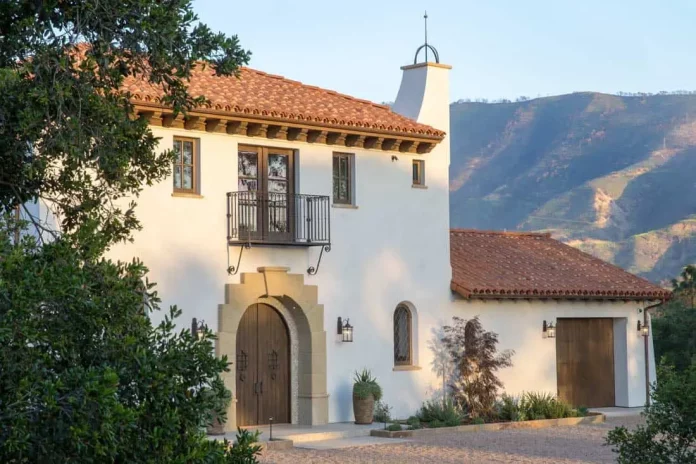
Hacienda architectural style reflects the fusion of cultures and historical influences from the regions of Spain, Mexico, and the United States, leaving an indelible mark on the built environment. Its enduring popularity today is a tribute to its timeless appeal, blending rustic authenticity with elegant charm.
Designed to shield the residence from the harsh elements and provide cooling during the summer, these homes feature numerous verandahs and porches that capture the breezes from the southeast. The intricate details involve hand-carving and hand-forging, utilizing materials indigenous to the region. These structures were both opulent and contemporary, grounded in the distinctive craftsmanship that infused every aspect of their design.
Haciendas offer an opportunity for introspection into our past and a deeper comprehension of the fundamental principles underlying modern architectural concepts.

The Genesis of Hacienda Architectural Style
In the 16th century, Spanish kings rewarded conquistadores (Spanish for “conquerors”, addressing Spanish explorer-soldiers) for their military and social services with extensive lands, leading to the establishment of haciendas—rural estates providing resources to surrounding communities. Originating from the Spanish word for “estate in the country,” haciendas evolved architecturally through indigenous techniques within the context of mud construction and wooded landscapes. As hubs of cultural exchange, haciendas developed a distinct architectural style, spreading from Spain and Mexico to the southwestern United States during the Colonial Revival movement.
With a history dating back almost four centuries, hacienda-style homes flourished in states like California, Arizona, New Mexico, and Florida between the 1600s and mid-1800s. Spanish settlers strategically chose areas with climates resembling their homelands, enabling the use of traditional building styles and materials such as adobe and red clay. Despite the conclusion of the Spanish Colonial period in the mid-1800s, hacienda-style homes persisted as a favored architectural choice, gaining further popularity during the 1900s Colonial Revival movement. This enduring style, rooted in tradition, continues to showcase key elements and regional variations in contemporary hacienda architecture.

Elements of Hacienda Homes
Hacienda architecture is defined by a set of distinctive elements that contribute to its unique appeal.
Clay Roof Tiles

A hallmark of hacienda architecture, the clay roof tiles create a striking contrast with the white walls and add a touch of warmth to the exterior. These tiles also help keep the interiors cool by capturing and releasing the air, creating a natural ventilation system.
Stucco Walls

Stucco Walls reflect the Spanish and Mexican origins of Hacienda style. They are made from a type of plaster that is applied over a wire mesh or wooden lath, creating a smooth or textured surface that can be painted or left natural. These walls prevent heat from entering or escaping, and reflect sunlight, reducing the need for artificial lighting.
Round Doorways and Archways

Archways add a sense of grace and fluidity, by creating a welcoming and spacious aesthetic. They also allow for better air circulation, create shade and reduce glare, depending on the orientation and size of the openings.
Courtyards

Courtyards are central to the hacienda lifestyle, as they provide a place for socializing, relaxing, and enjoying nature. As an architectural feature, they have a cooling effect as they create a microclimate within the building. Moreover, the plants and water features in the courtyards help in lowering the temperature by evaporation and transpiration.
Exposed Wooden Beams

The wooden beams extend from the walls, providing structural support for the roof while imparting a rustic charm that evokes a sense of history and tradition within the hacienda. Additionally, they play a crucial role in temperature regulation by creating a space between the roof and ceiling. This design feature facilitates the upward movement and escape of hot air. Furthermore, the beams contribute to a natural ventilation system, allowing the seamless flow of air through the gaps.
Small Windows

These are common in hacienda architecture, as they reduce the amount of heat and light that enters the building. They also create a cosy and intimate atmosphere, as well as a sense of privacy and security. They can be decorated with wrought iron grilles, wooden shutters, or colourful curtains to add some flair and personality to the hacienda.
The Different Typologies of Hacienda Architecture
As these Hacienda homes were brought to the southwestern US, they adapted to the regional variations and developed sub-styles with distinctive features depending on the climate, culture, and resources of different areas.
Mexican Hacienda-Style Homes

Usually large and rustic, these traditional Hacienda homes extensively feature adobe, wood and thatch.
Spanish Colonial Hacienda Style Homes

Spanish Haciendas are composed of arches, columns and beautiful tilework, rendering them classic and elegant.
Texan Hacienda Style Homes

Texan Haciendas are more wood-based and cowboy-themed, made with regional materials and decor.
Fascination

The timeless elegance, cosy ambience, and authentic appeal of hacienda-style homes ensure their place in architectural history, offering a glimpse into a bygone era while remaining an integral part of contemporary design aesthetics.
Finding hacienda-style homes today can be an adventure in itself. While regions like Santa Fe, New Mexico, and parts of California showcase an abundance of these architectural gems, their popularity has spurred the integration of hacienda elements into modern home designs across various locations.
Whether seeking a historic estate or a newly constructed residence inspired by this style, opportunities abound for experiencing the charm of hacienda architecture.
References
- https://douglasnewby.com/2008/12/haciendas-reflect-history-and-origins-of-texas-modern/
- https://www.mexconnect.com/articles/1928-architecture-of-mexico-the-hacienda/
- https://www.thespruce.com/what-is-hacienda-architecture-5075599
- https://www.homedit.com/house-styles/architecture-of-hacienda-style-homes/
- https://www.realsimple.com/what-are-hacienda-homes-7555257
- https://www.excellenceresorts.com/blog/learn-about-mexican-architecture-and-the-history-behind-the-hacienda-style/
- https://www.riosinteriors.com/blog/everything-you-need-to-know-about-hacienda-design
- https://zelmanstyle.com/2020/12/06/what-is-hacienda-style/
